Cardiovascular Disorder in Australia: Public Health Burden Report
VerifiedAdded on 2023/02/01
|7
|1726
|83
Report
AI Summary
This report provides a comprehensive analysis of cardiovascular disorder (CVD) in Australia, highlighting its significance as a major cause of death and a national health burden. The report details the prevalence of CVD, affecting millions of Australians, and examines the associated mortality rates and economic impact, including healthcare expenditures and disability-adjusted life years lost. It explores both modifiable and non-modifiable risk factors, such as age, ethnicity, lifestyle choices (smoking, diet, exercise), and social determinants of health (education, income, cultural factors). The report emphasizes the need to address these risk factors and social determinants to manage the prevalence of CVD and improve the future health of Australians. The study references various research papers and statistical analyses from organizations such as the Australian Bureau of Statistics and the Heart Foundation of Australia. This detailed analysis helps to understand the complexities of CVD within the Australian context.
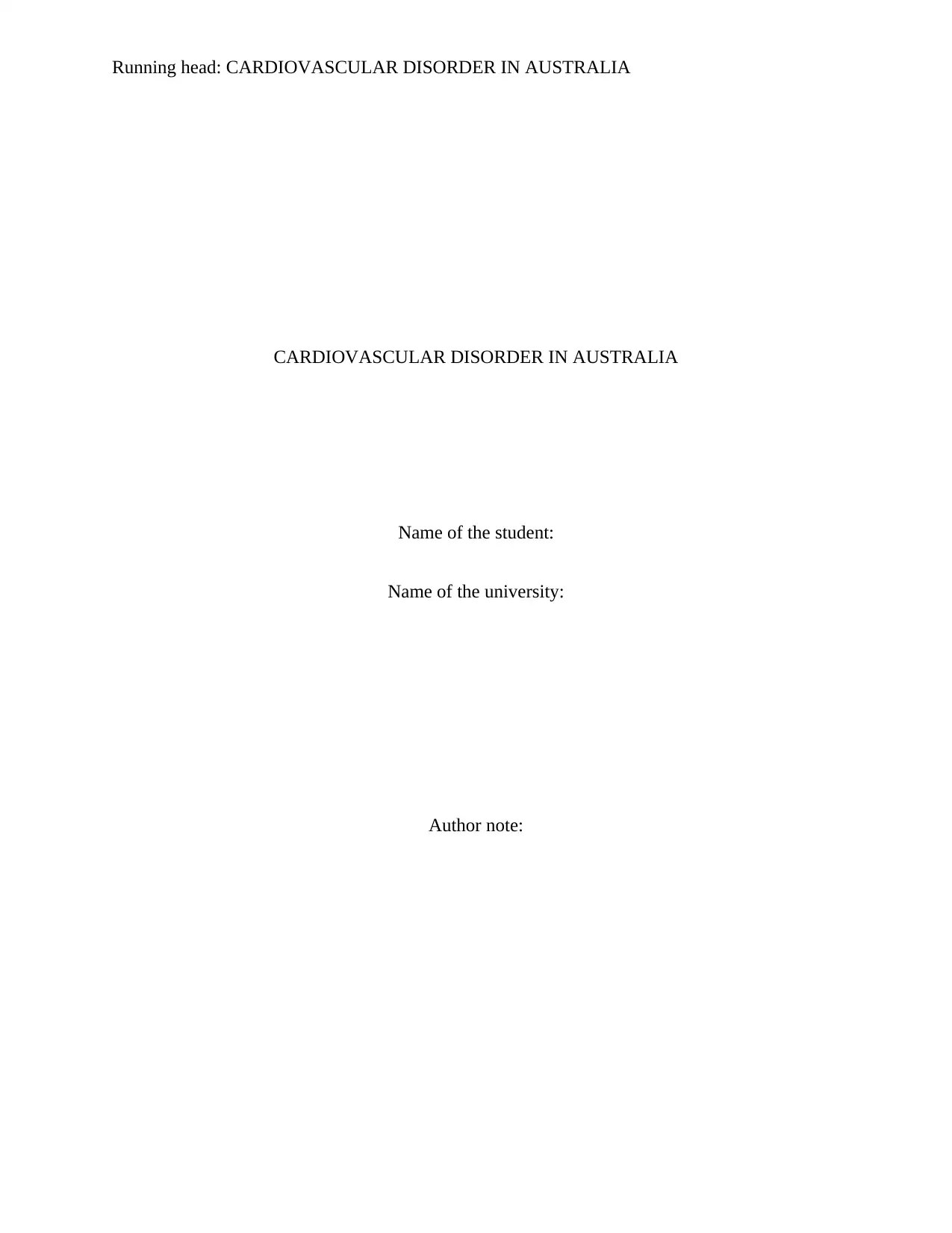
Running head: CARDIOVASCULAR DISORDER IN AUSTRALIA
CARDIOVASCULAR DISORDER IN AUSTRALIA
Name of the student:
Name of the university:
Author note:
CARDIOVASCULAR DISORDER IN AUSTRALIA
Name of the student:
Name of the university:
Author note:
Paraphrase This Document
Need a fresh take? Get an instant paraphrase of this document with our AI Paraphraser
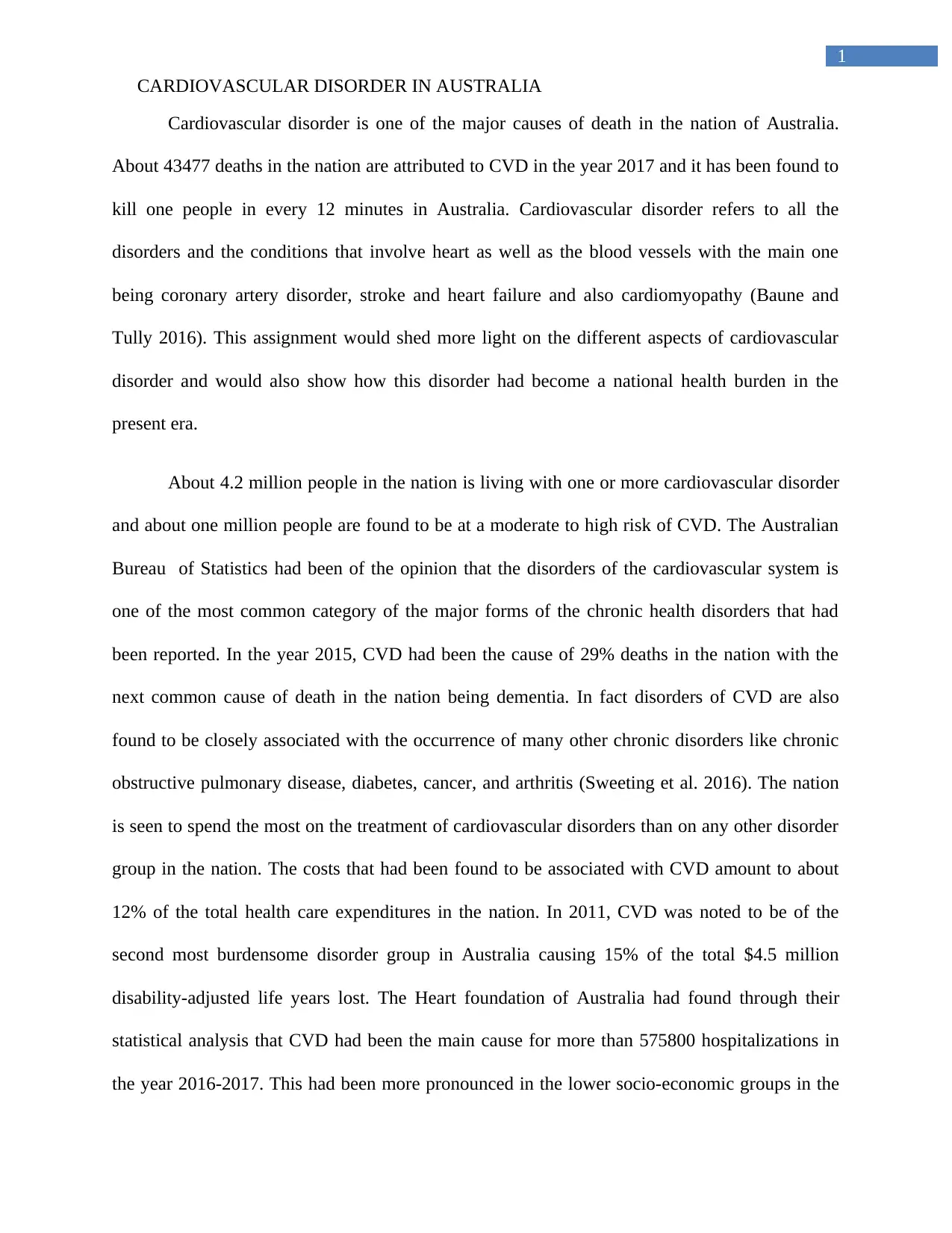
1
CARDIOVASCULAR DISORDER IN AUSTRALIA
Cardiovascular disorder is one of the major causes of death in the nation of Australia.
About 43477 deaths in the nation are attributed to CVD in the year 2017 and it has been found to
kill one people in every 12 minutes in Australia. Cardiovascular disorder refers to all the
disorders and the conditions that involve heart as well as the blood vessels with the main one
being coronary artery disorder, stroke and heart failure and also cardiomyopathy (Baune and
Tully 2016). This assignment would shed more light on the different aspects of cardiovascular
disorder and would also show how this disorder had become a national health burden in the
present era.
About 4.2 million people in the nation is living with one or more cardiovascular disorder
and about one million people are found to be at a moderate to high risk of CVD. The Australian
Bureau of Statistics had been of the opinion that the disorders of the cardiovascular system is
one of the most common category of the major forms of the chronic health disorders that had
been reported. In the year 2015, CVD had been the cause of 29% deaths in the nation with the
next common cause of death in the nation being dementia. In fact disorders of CVD are also
found to be closely associated with the occurrence of many other chronic disorders like chronic
obstructive pulmonary disease, diabetes, cancer, and arthritis (Sweeting et al. 2016). The nation
is seen to spend the most on the treatment of cardiovascular disorders than on any other disorder
group in the nation. The costs that had been found to be associated with CVD amount to about
12% of the total health care expenditures in the nation. In 2011, CVD was noted to be of the
second most burdensome disorder group in Australia causing 15% of the total $4.5 million
disability-adjusted life years lost. The Heart foundation of Australia had found through their
statistical analysis that CVD had been the main cause for more than 575800 hospitalizations in
the year 2016-2017. This had been more pronounced in the lower socio-economic groups in the
CARDIOVASCULAR DISORDER IN AUSTRALIA
Cardiovascular disorder is one of the major causes of death in the nation of Australia.
About 43477 deaths in the nation are attributed to CVD in the year 2017 and it has been found to
kill one people in every 12 minutes in Australia. Cardiovascular disorder refers to all the
disorders and the conditions that involve heart as well as the blood vessels with the main one
being coronary artery disorder, stroke and heart failure and also cardiomyopathy (Baune and
Tully 2016). This assignment would shed more light on the different aspects of cardiovascular
disorder and would also show how this disorder had become a national health burden in the
present era.
About 4.2 million people in the nation is living with one or more cardiovascular disorder
and about one million people are found to be at a moderate to high risk of CVD. The Australian
Bureau of Statistics had been of the opinion that the disorders of the cardiovascular system is
one of the most common category of the major forms of the chronic health disorders that had
been reported. In the year 2015, CVD had been the cause of 29% deaths in the nation with the
next common cause of death in the nation being dementia. In fact disorders of CVD are also
found to be closely associated with the occurrence of many other chronic disorders like chronic
obstructive pulmonary disease, diabetes, cancer, and arthritis (Sweeting et al. 2016). The nation
is seen to spend the most on the treatment of cardiovascular disorders than on any other disorder
group in the nation. The costs that had been found to be associated with CVD amount to about
12% of the total health care expenditures in the nation. In 2011, CVD was noted to be of the
second most burdensome disorder group in Australia causing 15% of the total $4.5 million
disability-adjusted life years lost. The Heart foundation of Australia had found through their
statistical analysis that CVD had been the main cause for more than 575800 hospitalizations in
the year 2016-2017. This had been more pronounced in the lower socio-economic groups in the
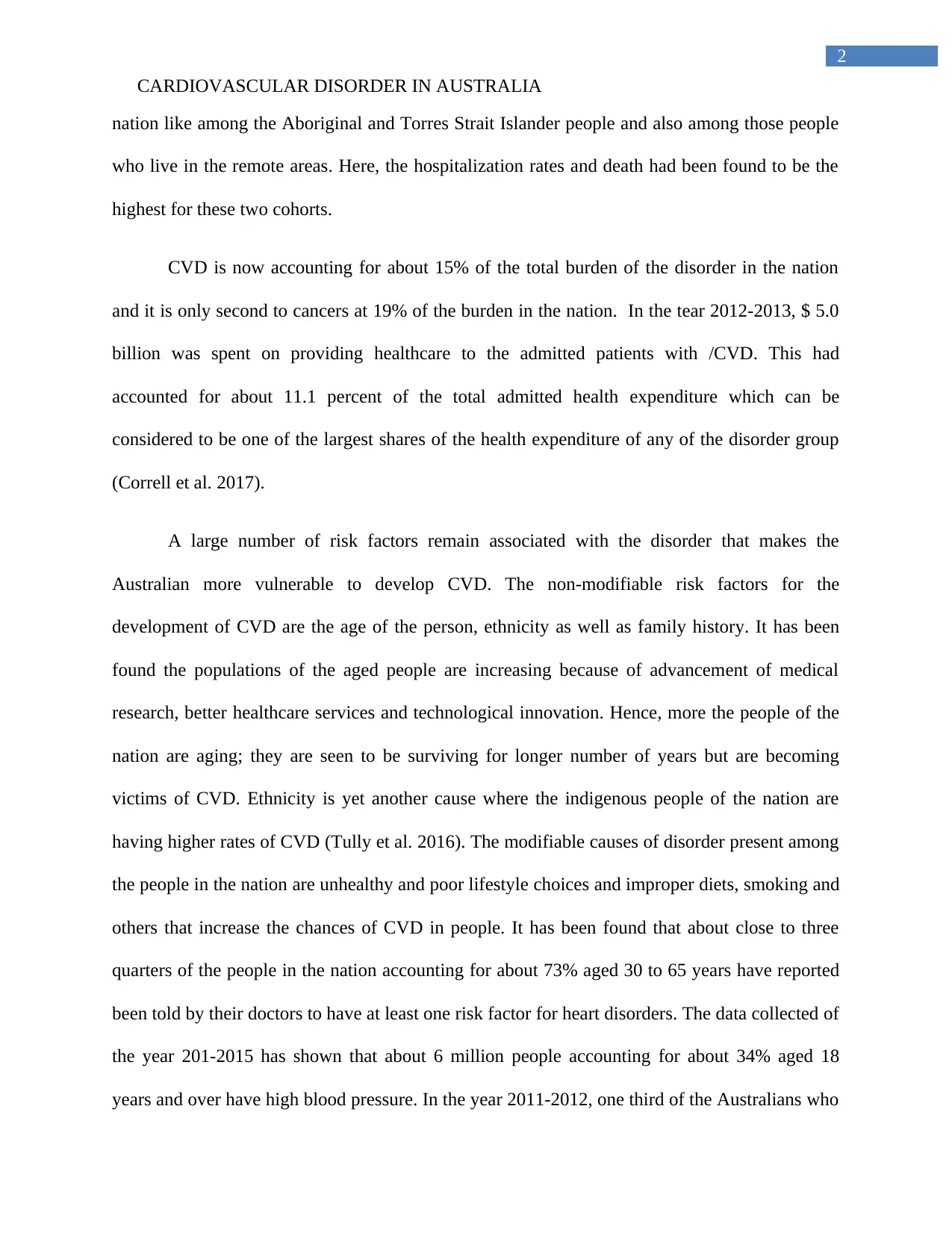
2
CARDIOVASCULAR DISORDER IN AUSTRALIA
nation like among the Aboriginal and Torres Strait Islander people and also among those people
who live in the remote areas. Here, the hospitalization rates and death had been found to be the
highest for these two cohorts.
CVD is now accounting for about 15% of the total burden of the disorder in the nation
and it is only second to cancers at 19% of the burden in the nation. In the tear 2012-2013, $ 5.0
billion was spent on providing healthcare to the admitted patients with /CVD. This had
accounted for about 11.1 percent of the total admitted health expenditure which can be
considered to be one of the largest shares of the health expenditure of any of the disorder group
(Correll et al. 2017).
A large number of risk factors remain associated with the disorder that makes the
Australian more vulnerable to develop CVD. The non-modifiable risk factors for the
development of CVD are the age of the person, ethnicity as well as family history. It has been
found the populations of the aged people are increasing because of advancement of medical
research, better healthcare services and technological innovation. Hence, more the people of the
nation are aging; they are seen to be surviving for longer number of years but are becoming
victims of CVD. Ethnicity is yet another cause where the indigenous people of the nation are
having higher rates of CVD (Tully et al. 2016). The modifiable causes of disorder present among
the people in the nation are unhealthy and poor lifestyle choices and improper diets, smoking and
others that increase the chances of CVD in people. It has been found that about close to three
quarters of the people in the nation accounting for about 73% aged 30 to 65 years have reported
been told by their doctors to have at least one risk factor for heart disorders. The data collected of
the year 201-2015 has shown that about 6 million people accounting for about 34% aged 18
years and over have high blood pressure. In the year 2011-2012, one third of the Australians who
CARDIOVASCULAR DISORDER IN AUSTRALIA
nation like among the Aboriginal and Torres Strait Islander people and also among those people
who live in the remote areas. Here, the hospitalization rates and death had been found to be the
highest for these two cohorts.
CVD is now accounting for about 15% of the total burden of the disorder in the nation
and it is only second to cancers at 19% of the burden in the nation. In the tear 2012-2013, $ 5.0
billion was spent on providing healthcare to the admitted patients with /CVD. This had
accounted for about 11.1 percent of the total admitted health expenditure which can be
considered to be one of the largest shares of the health expenditure of any of the disorder group
(Correll et al. 2017).
A large number of risk factors remain associated with the disorder that makes the
Australian more vulnerable to develop CVD. The non-modifiable risk factors for the
development of CVD are the age of the person, ethnicity as well as family history. It has been
found the populations of the aged people are increasing because of advancement of medical
research, better healthcare services and technological innovation. Hence, more the people of the
nation are aging; they are seen to be surviving for longer number of years but are becoming
victims of CVD. Ethnicity is yet another cause where the indigenous people of the nation are
having higher rates of CVD (Tully et al. 2016). The modifiable causes of disorder present among
the people in the nation are unhealthy and poor lifestyle choices and improper diets, smoking and
others that increase the chances of CVD in people. It has been found that about close to three
quarters of the people in the nation accounting for about 73% aged 30 to 65 years have reported
been told by their doctors to have at least one risk factor for heart disorders. The data collected of
the year 201-2015 has shown that about 6 million people accounting for about 34% aged 18
years and over have high blood pressure. In the year 2011-2012, one third of the Australians who
⊘ This is a preview!⊘
Do you want full access?
Subscribe today to unlock all pages.

Trusted by 1+ million students worldwide
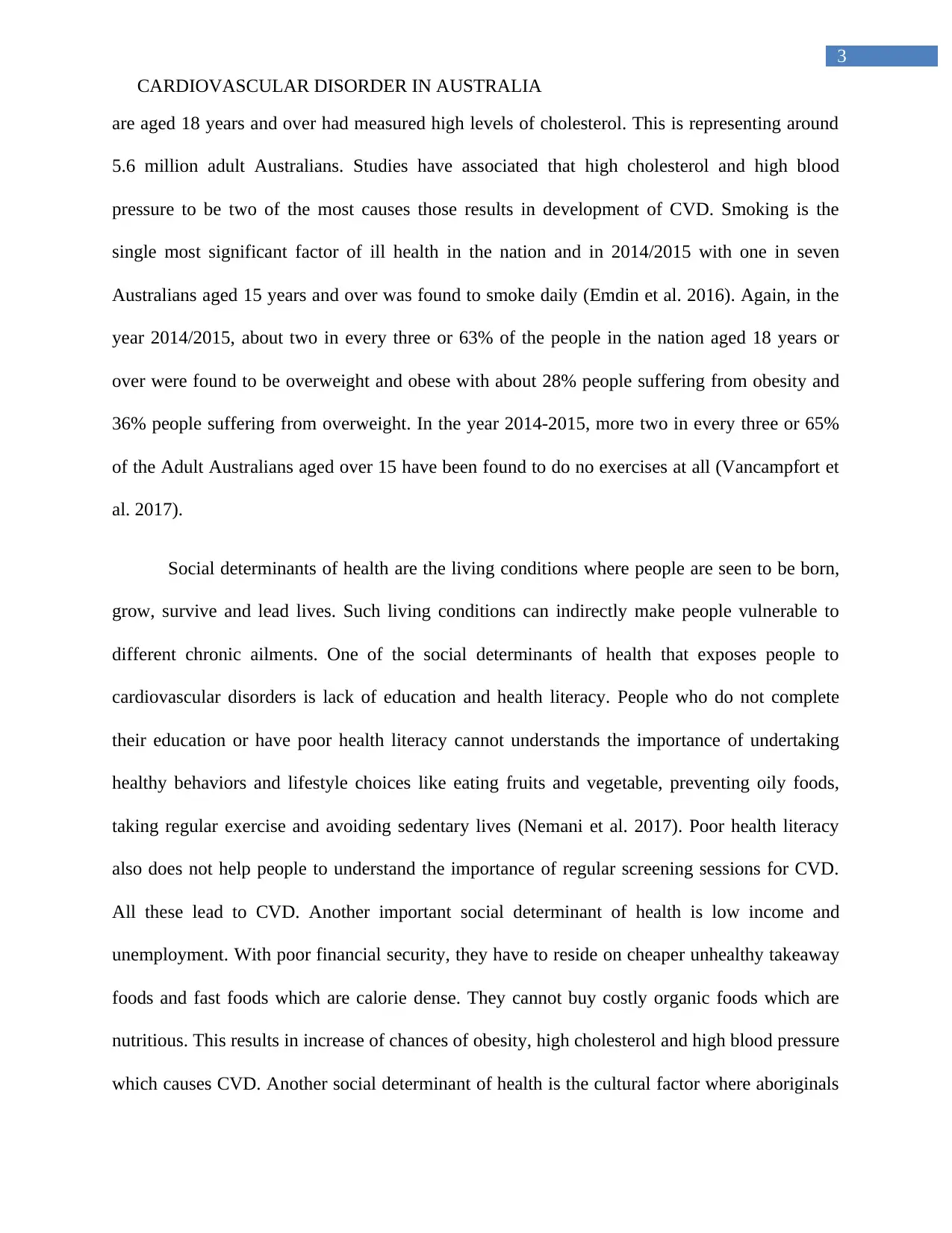
3
CARDIOVASCULAR DISORDER IN AUSTRALIA
are aged 18 years and over had measured high levels of cholesterol. This is representing around
5.6 million adult Australians. Studies have associated that high cholesterol and high blood
pressure to be two of the most causes those results in development of CVD. Smoking is the
single most significant factor of ill health in the nation and in 2014/2015 with one in seven
Australians aged 15 years and over was found to smoke daily (Emdin et al. 2016). Again, in the
year 2014/2015, about two in every three or 63% of the people in the nation aged 18 years or
over were found to be overweight and obese with about 28% people suffering from obesity and
36% people suffering from overweight. In the year 2014-2015, more two in every three or 65%
of the Adult Australians aged over 15 have been found to do no exercises at all (Vancampfort et
al. 2017).
Social determinants of health are the living conditions where people are seen to be born,
grow, survive and lead lives. Such living conditions can indirectly make people vulnerable to
different chronic ailments. One of the social determinants of health that exposes people to
cardiovascular disorders is lack of education and health literacy. People who do not complete
their education or have poor health literacy cannot understands the importance of undertaking
healthy behaviors and lifestyle choices like eating fruits and vegetable, preventing oily foods,
taking regular exercise and avoiding sedentary lives (Nemani et al. 2017). Poor health literacy
also does not help people to understand the importance of regular screening sessions for CVD.
All these lead to CVD. Another important social determinant of health is low income and
unemployment. With poor financial security, they have to reside on cheaper unhealthy takeaway
foods and fast foods which are calorie dense. They cannot buy costly organic foods which are
nutritious. This results in increase of chances of obesity, high cholesterol and high blood pressure
which causes CVD. Another social determinant of health is the cultural factor where aboriginals
CARDIOVASCULAR DISORDER IN AUSTRALIA
are aged 18 years and over had measured high levels of cholesterol. This is representing around
5.6 million adult Australians. Studies have associated that high cholesterol and high blood
pressure to be two of the most causes those results in development of CVD. Smoking is the
single most significant factor of ill health in the nation and in 2014/2015 with one in seven
Australians aged 15 years and over was found to smoke daily (Emdin et al. 2016). Again, in the
year 2014/2015, about two in every three or 63% of the people in the nation aged 18 years or
over were found to be overweight and obese with about 28% people suffering from obesity and
36% people suffering from overweight. In the year 2014-2015, more two in every three or 65%
of the Adult Australians aged over 15 have been found to do no exercises at all (Vancampfort et
al. 2017).
Social determinants of health are the living conditions where people are seen to be born,
grow, survive and lead lives. Such living conditions can indirectly make people vulnerable to
different chronic ailments. One of the social determinants of health that exposes people to
cardiovascular disorders is lack of education and health literacy. People who do not complete
their education or have poor health literacy cannot understands the importance of undertaking
healthy behaviors and lifestyle choices like eating fruits and vegetable, preventing oily foods,
taking regular exercise and avoiding sedentary lives (Nemani et al. 2017). Poor health literacy
also does not help people to understand the importance of regular screening sessions for CVD.
All these lead to CVD. Another important social determinant of health is low income and
unemployment. With poor financial security, they have to reside on cheaper unhealthy takeaway
foods and fast foods which are calorie dense. They cannot buy costly organic foods which are
nutritious. This results in increase of chances of obesity, high cholesterol and high blood pressure
which causes CVD. Another social determinant of health is the cultural factor where aboriginals
Paraphrase This Document
Need a fresh take? Get an instant paraphrase of this document with our AI Paraphraser
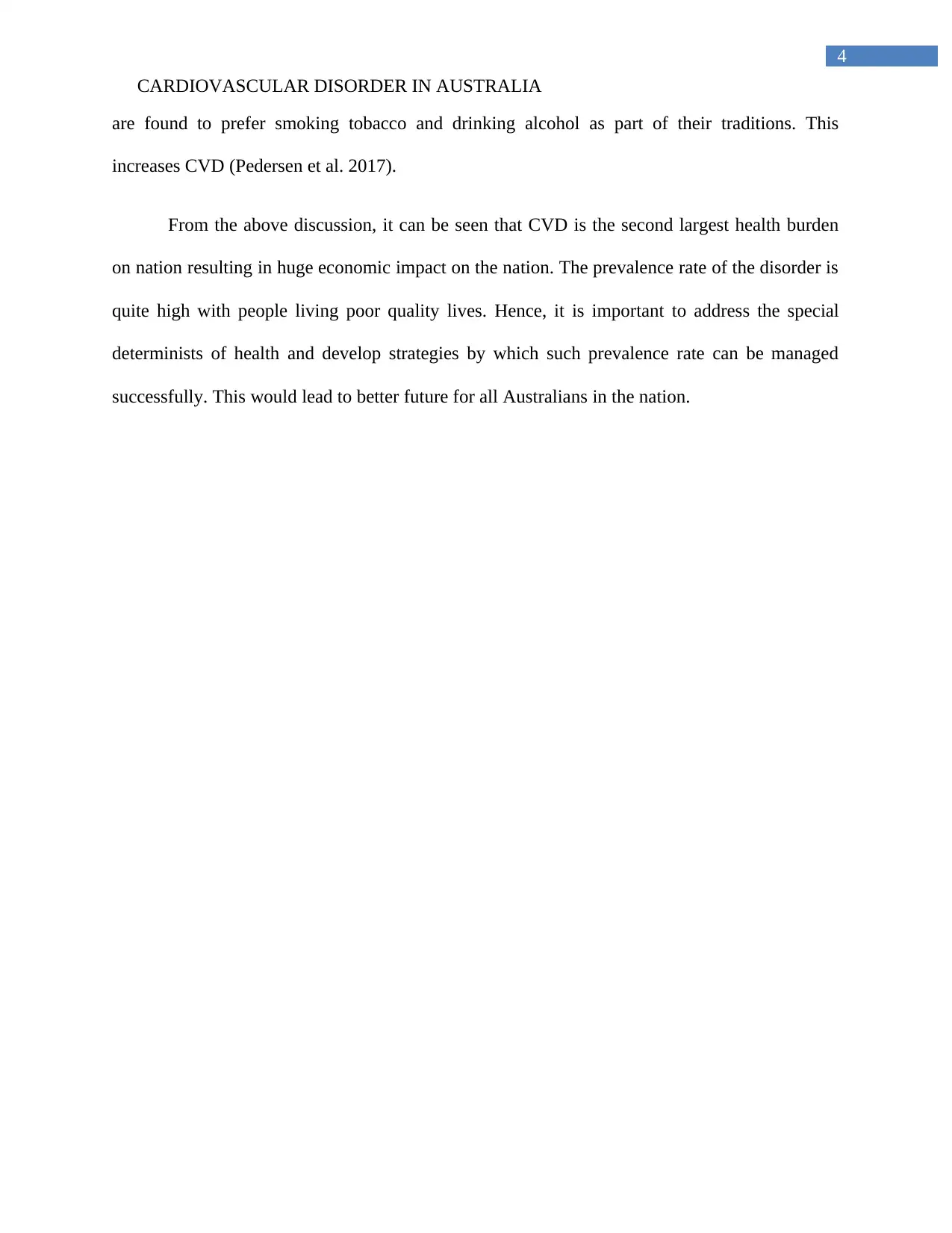
4
CARDIOVASCULAR DISORDER IN AUSTRALIA
are found to prefer smoking tobacco and drinking alcohol as part of their traditions. This
increases CVD (Pedersen et al. 2017).
From the above discussion, it can be seen that CVD is the second largest health burden
on nation resulting in huge economic impact on the nation. The prevalence rate of the disorder is
quite high with people living poor quality lives. Hence, it is important to address the special
determinists of health and develop strategies by which such prevalence rate can be managed
successfully. This would lead to better future for all Australians in the nation.
CARDIOVASCULAR DISORDER IN AUSTRALIA
are found to prefer smoking tobacco and drinking alcohol as part of their traditions. This
increases CVD (Pedersen et al. 2017).
From the above discussion, it can be seen that CVD is the second largest health burden
on nation resulting in huge economic impact on the nation. The prevalence rate of the disorder is
quite high with people living poor quality lives. Hence, it is important to address the special
determinists of health and develop strategies by which such prevalence rate can be managed
successfully. This would lead to better future for all Australians in the nation.
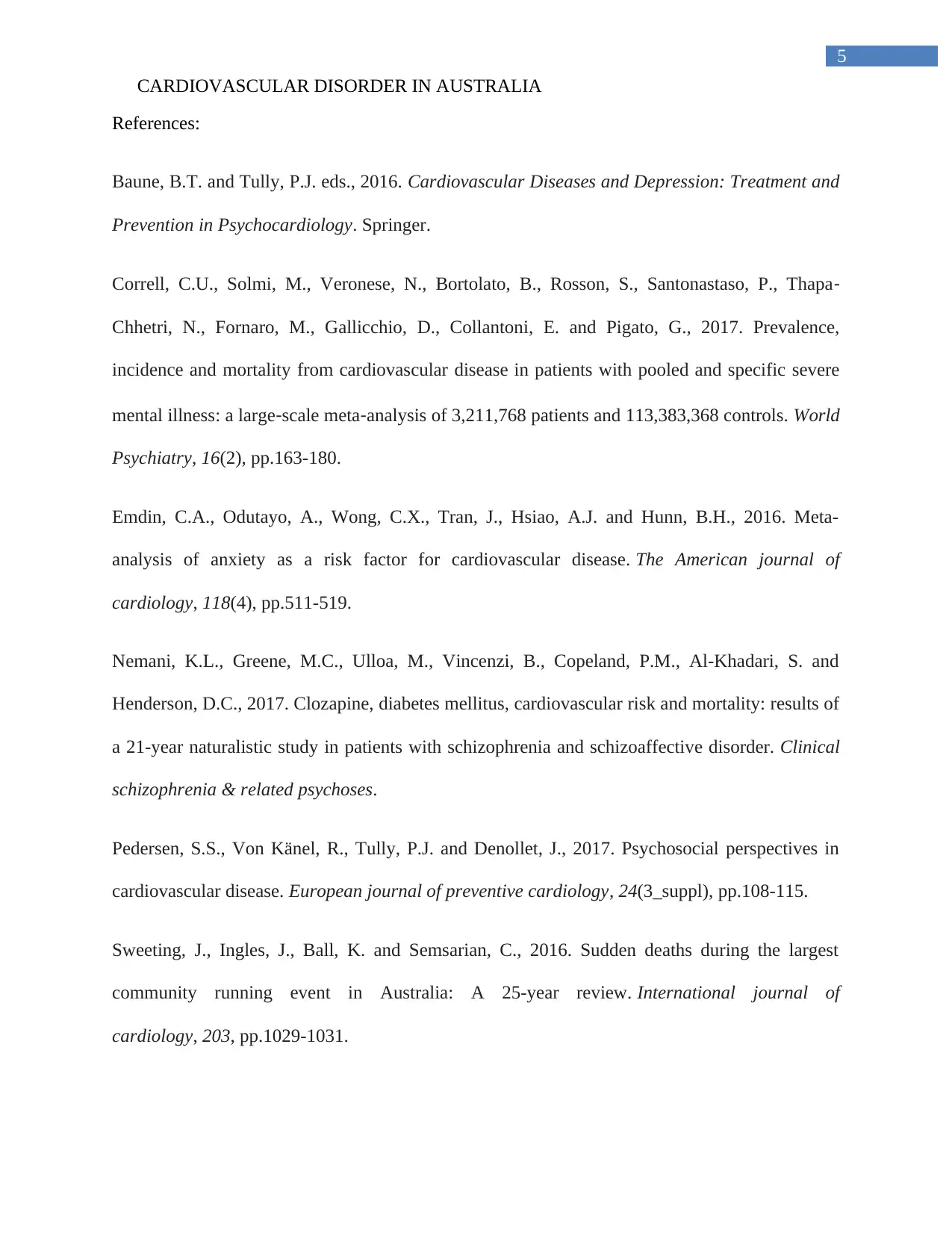
5
CARDIOVASCULAR DISORDER IN AUSTRALIA
References:
Baune, B.T. and Tully, P.J. eds., 2016. Cardiovascular Diseases and Depression: Treatment and
Prevention in Psychocardiology. Springer.
Correll, C.U., Solmi, M., Veronese, N., Bortolato, B., Rosson, S., Santonastaso, P., Thapa‐
Chhetri, N., Fornaro, M., Gallicchio, D., Collantoni, E. and Pigato, G., 2017. Prevalence,
incidence and mortality from cardiovascular disease in patients with pooled and specific severe
mental illness: a large‐scale meta‐analysis of 3,211,768 patients and 113,383,368 controls. World
Psychiatry, 16(2), pp.163-180.
Emdin, C.A., Odutayo, A., Wong, C.X., Tran, J., Hsiao, A.J. and Hunn, B.H., 2016. Meta-
analysis of anxiety as a risk factor for cardiovascular disease. The American journal of
cardiology, 118(4), pp.511-519.
Nemani, K.L., Greene, M.C., Ulloa, M., Vincenzi, B., Copeland, P.M., Al-Khadari, S. and
Henderson, D.C., 2017. Clozapine, diabetes mellitus, cardiovascular risk and mortality: results of
a 21-year naturalistic study in patients with schizophrenia and schizoaffective disorder. Clinical
schizophrenia & related psychoses.
Pedersen, S.S., Von Känel, R., Tully, P.J. and Denollet, J., 2017. Psychosocial perspectives in
cardiovascular disease. European journal of preventive cardiology, 24(3_suppl), pp.108-115.
Sweeting, J., Ingles, J., Ball, K. and Semsarian, C., 2016. Sudden deaths during the largest
community running event in Australia: A 25-year review. International journal of
cardiology, 203, pp.1029-1031.
CARDIOVASCULAR DISORDER IN AUSTRALIA
References:
Baune, B.T. and Tully, P.J. eds., 2016. Cardiovascular Diseases and Depression: Treatment and
Prevention in Psychocardiology. Springer.
Correll, C.U., Solmi, M., Veronese, N., Bortolato, B., Rosson, S., Santonastaso, P., Thapa‐
Chhetri, N., Fornaro, M., Gallicchio, D., Collantoni, E. and Pigato, G., 2017. Prevalence,
incidence and mortality from cardiovascular disease in patients with pooled and specific severe
mental illness: a large‐scale meta‐analysis of 3,211,768 patients and 113,383,368 controls. World
Psychiatry, 16(2), pp.163-180.
Emdin, C.A., Odutayo, A., Wong, C.X., Tran, J., Hsiao, A.J. and Hunn, B.H., 2016. Meta-
analysis of anxiety as a risk factor for cardiovascular disease. The American journal of
cardiology, 118(4), pp.511-519.
Nemani, K.L., Greene, M.C., Ulloa, M., Vincenzi, B., Copeland, P.M., Al-Khadari, S. and
Henderson, D.C., 2017. Clozapine, diabetes mellitus, cardiovascular risk and mortality: results of
a 21-year naturalistic study in patients with schizophrenia and schizoaffective disorder. Clinical
schizophrenia & related psychoses.
Pedersen, S.S., Von Känel, R., Tully, P.J. and Denollet, J., 2017. Psychosocial perspectives in
cardiovascular disease. European journal of preventive cardiology, 24(3_suppl), pp.108-115.
Sweeting, J., Ingles, J., Ball, K. and Semsarian, C., 2016. Sudden deaths during the largest
community running event in Australia: A 25-year review. International journal of
cardiology, 203, pp.1029-1031.
⊘ This is a preview!⊘
Do you want full access?
Subscribe today to unlock all pages.

Trusted by 1+ million students worldwide
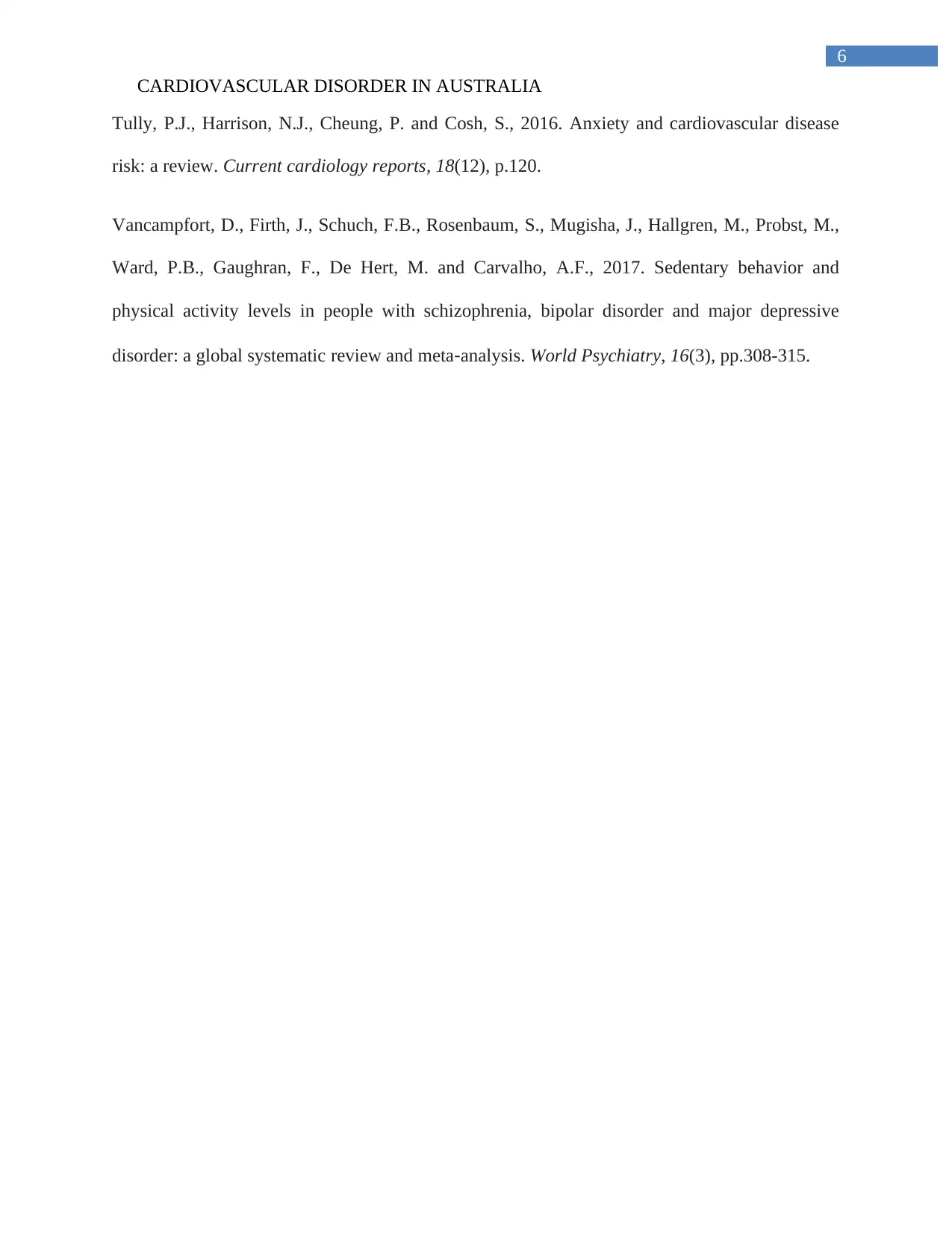
6
CARDIOVASCULAR DISORDER IN AUSTRALIA
Tully, P.J., Harrison, N.J., Cheung, P. and Cosh, S., 2016. Anxiety and cardiovascular disease
risk: a review. Current cardiology reports, 18(12), p.120.
Vancampfort, D., Firth, J., Schuch, F.B., Rosenbaum, S., Mugisha, J., Hallgren, M., Probst, M.,
Ward, P.B., Gaughran, F., De Hert, M. and Carvalho, A.F., 2017. Sedentary behavior and
physical activity levels in people with schizophrenia, bipolar disorder and major depressive
disorder: a global systematic review and meta‐analysis. World Psychiatry, 16(3), pp.308-315.
CARDIOVASCULAR DISORDER IN AUSTRALIA
Tully, P.J., Harrison, N.J., Cheung, P. and Cosh, S., 2016. Anxiety and cardiovascular disease
risk: a review. Current cardiology reports, 18(12), p.120.
Vancampfort, D., Firth, J., Schuch, F.B., Rosenbaum, S., Mugisha, J., Hallgren, M., Probst, M.,
Ward, P.B., Gaughran, F., De Hert, M. and Carvalho, A.F., 2017. Sedentary behavior and
physical activity levels in people with schizophrenia, bipolar disorder and major depressive
disorder: a global systematic review and meta‐analysis. World Psychiatry, 16(3), pp.308-315.
1 out of 7
Related Documents
Your All-in-One AI-Powered Toolkit for Academic Success.
+13062052269
info@desklib.com
Available 24*7 on WhatsApp / Email
![[object Object]](/_next/static/media/star-bottom.7253800d.svg)
Unlock your academic potential
Copyright © 2020–2025 A2Z Services. All Rights Reserved. Developed and managed by ZUCOL.





